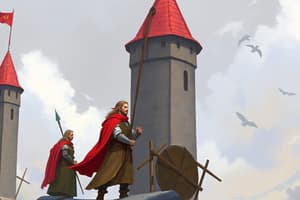Podcast
Questions and Answers
What were castles primarily constructed for during the Middle Ages?
What were castles primarily constructed for during the Middle Ages?
- To house religious artifacts
- To facilitate trade and commerce
- To provide shelter for peasants
- To serve as fortified residences for nobility (correct)
Which trading organization controlled the Baltic Sea region during the Middle Ages?
Which trading organization controlled the Baltic Sea region during the Middle Ages?
- The Transatlantic Union
- The Hanseatic League (correct)
- The Mediterranean Alliance
- The Silk Road Consortium
What characterized medieval art during the Middle Ages?
What characterized medieval art during the Middle Ages?
- Secularism and atheistic themes
- Political propaganda
- Religiosity with Christian themes (correct)
- Asian influences
How did the rise of new technologies impact trade in the Middle Ages?
How did the rise of new technologies impact trade in the Middle Ages?
What event had a significant impact on the balance of power between social classes in the Middle Ages?
What event had a significant impact on the balance of power between social classes in the Middle Ages?
Which literary development emerged during the Middle Ages as distinguished from Latin texts?
Which literary development emerged during the Middle Ages as distinguished from Latin texts?
What is another term for the Medieval Period?
What is another term for the Medieval Period?
Which event marked the beginning of the Middle Ages?
Which event marked the beginning of the Middle Ages?
What role did the Catholic Church play in the Middle Ages?
What role did the Catholic Church play in the Middle Ages?
What social structure characterized the Middle Ages?
What social structure characterized the Middle Ages?
What values were emphasized in chivalry during the Middle Ages?
What values were emphasized in chivalry during the Middle Ages?
What was the primary role of monasteries in the Middle Ages?
What was the primary role of monasteries in the Middle Ages?
Flashcards are hidden until you start studying
Study Notes
Unraveling the Middle Ages: A Tapestry of History
The Middle Ages, also known as the Medieval Period or Medieval Era, stretches from around the 5th to the 15th century, encompassing a complex tapestry of human achievement and transformation. This era, sandwiched between the fall of the Western Roman Empire (around 476 CE) and the onset of the Renaissance, is a period rich with intrigue, innovation, and cultural evolution.
Origins and Transformation
The Middle Ages began with the fragmentation of the Roman Empire and the rise of various kingdoms across Europe. During this time, local feudal lords and church leaders filled the power vacuum, developing a distinctive social structure and political landscape. The feudal system, characterized by a hierarchal relationship between landowners (lords) and their vassals (tenants), allowed for the establishment of a stable and ordered society.
The Catholic Church, a major institution throughout this era, not only played a significant role in shaping religious beliefs and practices but also acted as the primary source of literacy and education. Monasteries retained and copied ancient texts, fostering the preservation of knowledge in an age when few could read.
The World of Knights and Castles
Medieval society placed great value on chivalry, a code of conduct for knights, emphasizing courage, honor, and loyalty. Knights were bound by the bonds of fealty to their lords, often in return for military protection and land. This symbiotic relationship spawned a culture of tournaments, where knights would test their prowess in combat.
Castles, a symbol of wealth and power, were constructed as fortified residences for nobility and were often centrally located to control significant trade routes and protect against threats from neighboring territories. These stone giants were both military strongholds and architectural marvels, with the likes of Windsor Castle in England and Neuschwanstein Castle in Germany standing as testaments to this era's sophisticated engineering and construction.
Trading and Commerce
In the Middle Ages, trade was a vital component of European life, with merchants traveling along well-established trade routes. The Hanseatic League, for example, was a powerful trading organization that controlled the Baltic Sea, facilitating trade between Germany, Scandinavia, and Eastern Europe.
The rise of new technologies, such as the horse collar and watermill, helped to improve efficiency and productivity. Wind-powered mills, for instance, allowed for the processing of grain on a much larger scale, contributing to the growth of trade and commerce.
The Art of the Middle Ages
Medieval art was characterized by its religiosity, with Christian themes and symbols dominating the artistic landscape. The Romanesque and Gothic periods saw the construction of magnificent cathedrals, such as Notre-Dame in Paris and Chartres Cathedral, as well as the creation of illuminated manuscripts and sculptures.
The Middle Ages also saw the emergence of vernacular literature, as distinguished from the Latin texts of antiquity. Works like the epic poem "Beowulf" and the troubadour songs in Provencal demonstrate the vitality and creativity of vernacular literature, which would pave the way for future literary achievements.
The Black Death and Its Aftermath
The Black Death, a devastating outbreak of bubonic plague, swept through Europe during the Middle Ages, leaving an indelible mark on society. The plague led to a decline in population, drastically altering the balance of power between the nobility, the church, and the peasantry. The Black Death also stimulated scientific and medical inquiry, with scholars seeking to understand the causes and spread of the disease.
The Middle Ages were a time of intense cultural, social, and political change, laying the foundation for the Renaissance and the modern world. The era witnessed a spectacular blend of feudalism, chivalry, trade, and art that shaped the medieval world, leaving an indelible mark on European history.
Studying That Suits You
Use AI to generate personalized quizzes and flashcards to suit your learning preferences.




